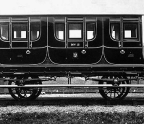
Rocket's sisters
Success at Rainhill led to the Liverpool & Manchester Railway board to award Booth and the Stephensons the ‘premium’ of £500. This premium was never paid, however, as due to the non-delivery of the second winding engine for the Wapping Tunnel (it was lost at sea) the L&M Finance Committee ordered that the £500 non-completion clause in the contract be deducted from the next bill payable to the Stephensons which, ironically, was the Rainhill Premium. However, despite this success, the ascendency of the Stephenson locomotive was not assured. The anti-Stephenson James Cropper and his ally Daniel Hodgson had been in correspondence with the Quaker engineer and scientist Goldsworthy Gurney (17931875). Gurney had developed a very successful steam road coach which presaged many of the design features of Robert Stephenson's later Planet locomotive. Thus at the Board Meeting of 26th October 1829, James Cropper “Read a letter, which he had received on the subject of Mr. Gurney's loco-motive steam carriages, mentioning that Mr. Gurney had 18 or 20 Steam Carriages building for the Common Roads.”1
A lengthy discussion took place “on the expediency of the Company being supplied with a certain number of Loco-Motive Engines to be ready for work early next year”. During this Cropper and Hodgson pushed the case for acquiring locomotives from Gurney so as to prevent any Stephenson monopoly of the L&M, which in part the Rainhill Trials had been established to challenge. Cropper and Hodgson were clearly out-voted as it was:
“RESOLVED that four locomotives on the Principle of the ‘Rocket’ be ordered from Robert Stephenson & Co. of Newcastle not to exceed five tons in weight each, to be delivered in Liverpool in three months from the present time.”2

However, Cropper and Hodgson would not give up so easily: they continued to push Gurney's case during November and the directors agreed to “allow a fair and liberal remuneration for the best Loco-Motive Carriage that could be produced”, such a machine being allowed a fair trial on the line. Gurney, whose road coach business was floundering, objected to building such a locomotive speculatively and wanted the L&M board to purchase it outright from him, more or less unseen. This the board refused to do. Things went quiet until May 1830 when Cropper reported to the board that he and Hodgson had held their own meetings with Gurney regarding him supplying locomotives and the board agreed in principal to Gurney building a locomotive, to the same design criteria as offered to Braithwaite & Ericsson for William IV and Queen Adelaide. Sadly no locomotive every materialised.
Arrow, Comet, Dart and Meteor
But to get back to Rocket's sisters. At a stroke Rocket was obsolete. The first of this quartet of ‘improved Rocket types’ was Wildfire alias Meteor. It was finished toward the end of December 1829 and “a large party of [Robert Stephenson's] friends assembled in the manufactory to witness its almost unprecedented powers”:
“The trial, though the engine was only temporarily fixed, which of course precluded the possibility of applying the full force of the steam, afforded a gratifying proof of the extraordinary speed at which the engine would be capable of moving, and the result was of the most satisfying description. Such was the surprising velocity, that during one period of the afternoon it was calculated that the machine




